Passenger Car Intelligent Steering Industry Report, 2023 released by ResearchInChina combs through and studies the status quo of passenger car intelligent steering and the product layout of OEMs, suppliers, and supply chains, and predicts the future development trends of passenger car intelligent steering.
1. The penetration rate of electric power steering (EPS) in the passenger car market almost hits the peak, and the iteration and upgrading of products reflect the current development direction.
From 2020 to 2023, the penetration of EPS in the Chinese passenger car market remained at a high level. In the next stage, EPS will head in the direction of high performance.
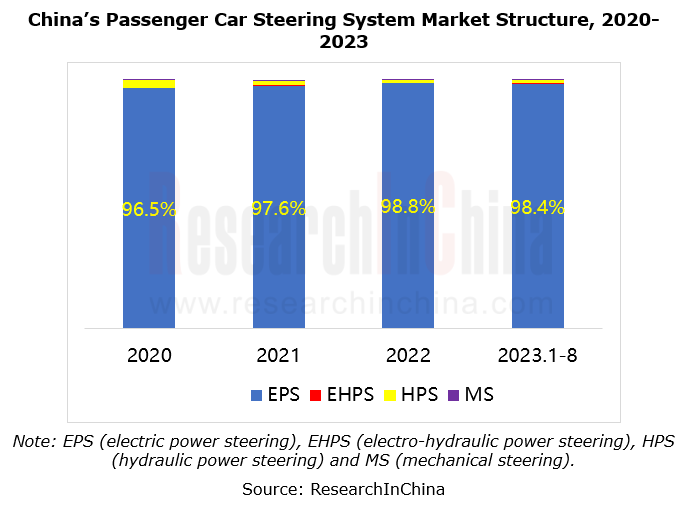
By the installation position of booster motor, EPS can be divided into four types: column EPS (C-EPS), pinion EPS (P-EPS), rack EPS (R-EPS) and dual pinion EPS (DP-EPS). In terms of transmission efficiency from high to low, the ranking is R-EPS/DP-EPS > P-EPS > C-EPS. As mid-to-high-end smart electric vehicles boom, the steering system is being upgraded from C-EPS to R-EPS and DP-EPS. The content-per-car value of the latter two is higher than that of C-EPS, and the iteration of the EPS product structure brings value increment.
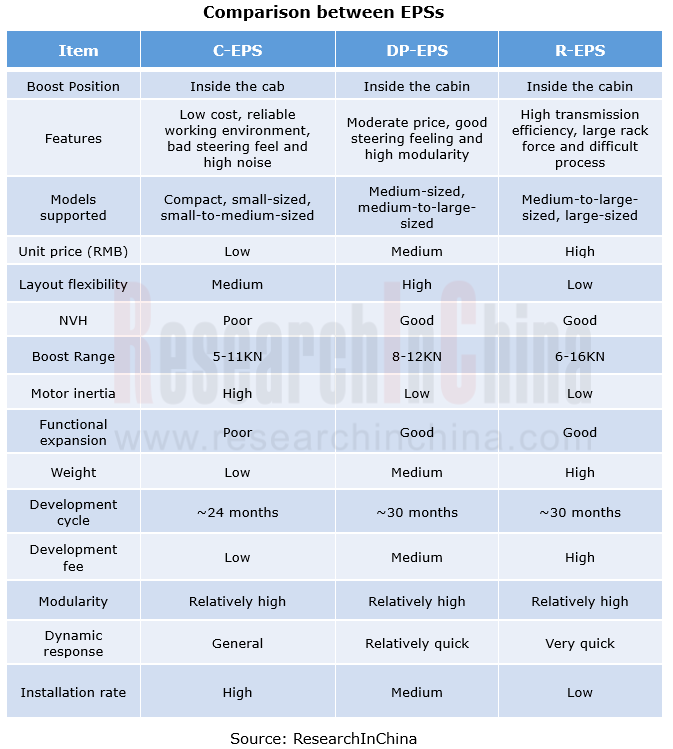
2. In the process of upgrading from EPS to SBW (steer-by-wire), redundant EPS and rear wheel steering become the transitional form.
L3 driving assistance requires EPS to still have a certain power-assisting capability in the event of a single point failure. Under this requirement, redundant EPS becomes the key component of L3+ intelligent driving systems.
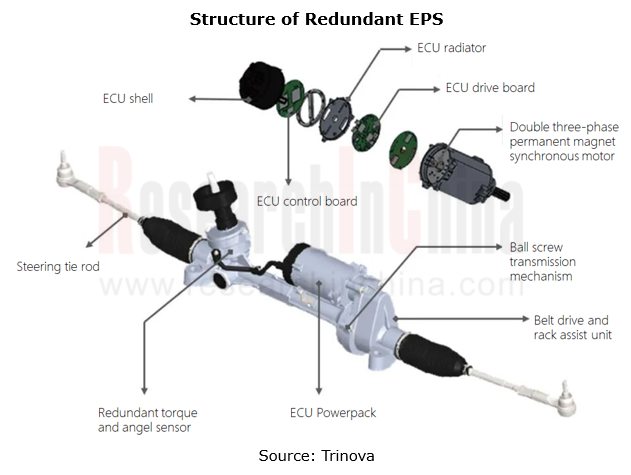
At present, OEMs and suppliers have made related product layout:
 Bosch HASCO's HE3r B3, which was rolled out in April 2023, adopts a 50%+50% redundancy solution. The two control loops have independent power supplies and communication modules and work together. If a functional failure occurs on either of them, 50% of the steering force can cover most working conditions and ensure constant driving.
Bosch HASCO's HE3r B3, which was rolled out in April 2023, adopts a 50%+50% redundancy solution. The two control loops have independent power supplies and communication modules and work together. If a functional failure occurs on either of them, 50% of the steering force can cover most working conditions and ensure constant driving.
 T-RES, a redundant electronically controlled steering system of Trinova, integrates dual winding motors, dual drive circuits, dual sensors and dual power management systems to meet the redundancy requirements of L3 autonomous driving.
T-RES, a redundant electronically controlled steering system of Trinova, integrates dual winding motors, dual drive circuits, dual sensors and dual power management systems to meet the redundancy requirements of L3 autonomous driving.
 The fully redundant DP-EPS of NASN has the maximum rack force of 13.5KN, suitable for medium SUVs, large SUVs, MPVs, pickup trucks and other pan-passenger vehicles. The whole series uses 6-phase dual winding motors to satisfy the requirements of ADAS and L3+ autonomous driving.
The fully redundant DP-EPS of NASN has the maximum rack force of 13.5KN, suitable for medium SUVs, large SUVs, MPVs, pickup trucks and other pan-passenger vehicles. The whole series uses 6-phase dual winding motors to satisfy the requirements of ADAS and L3+ autonomous driving.
 HYCET under Great Wall Motor is about to mass-produce dual redundant EPS with the maximum thrust of 14kN to enable L3+ autonomous driving.
HYCET under Great Wall Motor is about to mass-produce dual redundant EPS with the maximum thrust of 14kN to enable L3+ autonomous driving.
Redundant EPS will become a core technology in L3+ intelligent driving scenarios before mass production and application of steer-by-wire.
Rear wheel steering, as a supplement to front wheel steering, was originally used in large luxury cars and SUVs, such as BMW 5/7 Series and Audi Q7/8. On the one hand, rear wheel steering technology based on electrical operation is easier to implement on an all-electric platform. On the other hand, electric vehicles on an all-electric platform generally have a long wheelbase (the battery must be placed between the front and rear axles) which increases the turning radius, while rear wheel steering technology offers much higher flexibility. In recent years, as electrification has become widespread rapidly, rear wheel steering has landed on more models such as Xpeng X9, AITO M9 and IM L7.
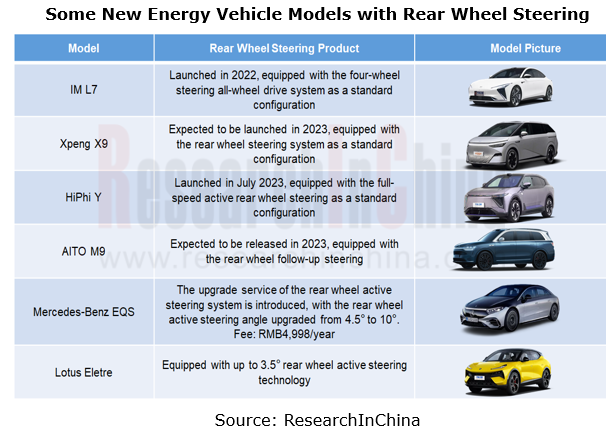
3. Suppliers and OEMs quicken their pace of deploying steer-by-wire, with more production models.
OEMs:
 Toyota and Tesla have submitted patent applications for steer-by-wire technology.
Toyota and Tesla have submitted patent applications for steer-by-wire technology.
 Great Wall Motor and Changan adopt their self-developed steer-by-wire products to deploy steer-by-wire.
Great Wall Motor and Changan adopt their self-developed steer-by-wire products to deploy steer-by-wire.
 Geely and Hella have jointly developed a steer-by-wire (SBW) system which is production-ready.
Geely and Hella have jointly developed a steer-by-wire (SBW) system which is production-ready.
 NIO and ZF cooperate on steer-by-wire products.
NIO and ZF cooperate on steer-by-wire products.
Suppliers:
 Nexteer Automotive has secured steer-by-wire system orders from two OEMs.
Nexteer Automotive has secured steer-by-wire system orders from two OEMs.
 Bethel Automotive Safety Systems, together with Chery's subsidiary Ruizhi Lianneng, acquired Wanda Auto for a layout shift to steer-by-wire R&D.
Bethel Automotive Safety Systems, together with Chery's subsidiary Ruizhi Lianneng, acquired Wanda Auto for a layout shift to steer-by-wire R&D.
 JTEKT’s steer-by-wire system was available to Toyota bZ4X in 2022 and will land on Lexus RZ in 2024.
JTEKT’s steer-by-wire system was available to Toyota bZ4X in 2022 and will land on Lexus RZ in 2024.
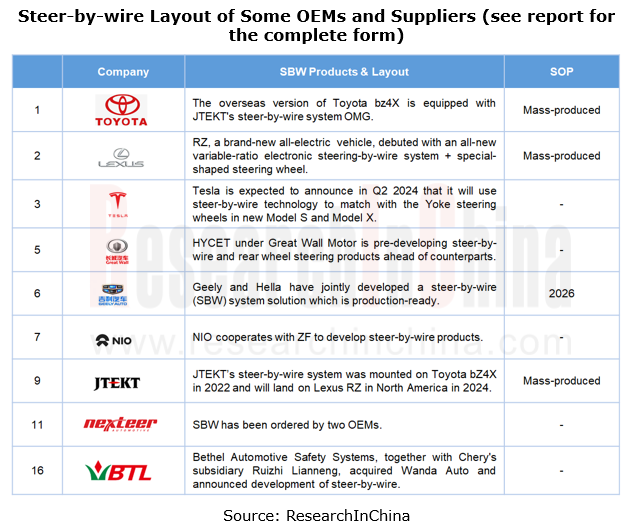
At present, many OEMs and suppliers make many deployments in steer-by-wire, but with a low product penetration. Nexteer Automotive forecasts that it is difficult for steer-by-wire to gain pace in the next 2 or 3 years.
The policy environment has become more relaxed in recent years. The development of steer-by-wire is driven by the demand for intelligent chassis and stimulated by policies. From the implementation of the new national automotive steering standard to the release of Steer-by-wire Technology Roadmap, steer-by-wire has been production-ready in terms of policies.
 On January 1, 2022, the new national automotive steering standard was officially implemented, deleting the 20-year-old requirement that full-power steering mechanisms should not be installed (steer-by-wire is full-power steering);
On January 1, 2022, the new national automotive steering standard was officially implemented, deleting the 20-year-old requirement that full-power steering mechanisms should not be installed (steer-by-wire is full-power steering);
 In April, 2022, the exposure draft of the Steer-by-wire Technology Roadmap was officially released. The overall goal is to realize the world’s leading steer-by-wire for L3+ and L4+ autonomous driving in 2025 and 2030, with the penetration of steer-by-wire up to 5% and 30% and the autonomy rate of core components (controller, motor, etc.) higher than 20% and 50%, respectively.
In April, 2022, the exposure draft of the Steer-by-wire Technology Roadmap was officially released. The overall goal is to realize the world’s leading steer-by-wire for L3+ and L4+ autonomous driving in 2025 and 2030, with the penetration of steer-by-wire up to 5% and 30% and the autonomy rate of core components (controller, motor, etc.) higher than 20% and 50%, respectively.
 In June 2023, the Ministry of Industry and Information Technology and other four ministries further proposed that "the automotive industry should focus on steer-by-wire".
In June 2023, the Ministry of Industry and Information Technology and other four ministries further proposed that "the automotive industry should focus on steer-by-wire".
New Energy Vehicle Cross-Domain (Electric Drive System and Powertrain Domain) Integration Trend Report 2025-2026
Electric Drive and Powertrain Domain Research: New technologies such as three-motor four-wheel drive, drive-brake integration, and corner modules are being rapidly installed in vehicles.
Electric dri...
Analysis on Desay SV and Joyson Electronic's Electrification, Connectivity, Intelligence and Sharing, 2025
Research on Desay SV and Joyson Electronic: Who is the No.1 Intelligent Supplier?
Both Desay SV and Joyson Electronic are leading domestic suppliers in automotive intelligence. "Analysis on Desay SV ...
OEMs and Tier 1 Suppliers' Cost Reduction and Efficiency Enhancement Strategy Analysis Report, 2025
ResearchInChina released the "OEMs and Tier 1 Suppliers' Cost Reduction and Efficiency Enhancement Strategy Analysis Report, 2025", summarizing hundreds of cost reduction strategies to provide referen...
Automotive Fixed Panoramic Sunroof and Smart Roof Research Report, 2025
With the intelligent application of car roofs as the core, this report systematically sorts out a series of new products such as fixed panoramic sunroof/openable sunroof, ceiling screen, roof ambient ...
Automotive-Grade Power Semiconductor and Module (SiC, GaN) Industry Research Report, 2025
SiC/GaN Research: Sales volume of 800V+ architecture-based vehicles will increase more than 10 times, and hybrid carbon (SiC+IGBT) power modules are rapidly being deployed in vehicles.
Sales volume o...
Cockpit Agent Engineering Research Report, 2025
Cockpit Agent Engineering Research: Breakthrough from Digital AI to Physical AI
Cockpit Agent Engineering Research Report, 2025 starts with the status quo of cockpit agents, summarizes the technical ...
Prospective Study on L3 Intelligent Driving Technology of OEMs and Tier 1 Suppliers, 2025
L3 Research: The Window of Opportunity Has Arrived - Eight Trends in L3 Layout of OEMs and Tier 1 Suppliers
Through in-depth research on 15 OEMs (including 8 Chinese and 7 foreign OEMs) and 9 Tier 1 ...
China Commercial Vehicle IoV and Intelligent Cockpit Industry Research Report 2025
Commercial Vehicle IoV and Cockpit Research: The Third Wave of Passenger Car/Commercial Vehicle Technology Integration Arrives, and T-Box Integrates e-Call and 15.6-inch for Vehicles
I. The third wav...
Intelligent Vehicle Electronic and Electrical Architecture (EEA) and Technology Supply Chain Construction Strategy Research Report, 2025
E/E Architecture Research: 24 OEMs Deploy Innovative Products from Platform Architectures to Technical Selling Points
According to statistics from ResearchInChina, 802,000 passenger cars with domain...
Research Report on Intelligent Vehicle Cross-Domain Integration Strategies and Innovative Function Scenarios, 2025
Cross-Domain Integration Strategy Research: Automakers' Competition Extends to Cross-Domain Innovative Function Scenarios such as Cockpit-Driving, Powertrain, and Chassis
Cross-domain integration of ...
China Autonomous Driving Data Closed Loop Research Report, 2025
Data Closed-Loop Research: Synthetic Data Accounts for Over 50%, Full-process Automated Toolchain Gradually Implemented
Key Points:From 2023 to 2025, the proportion of synthetic data increased from 2...
Automotive Glass and Smart Glass Research Report, 2025
Automotive Glass Report: Dimmable Glass Offers Active Mode, Penetration Rate Expected to Reach 10% by 2030
ResearchInChina releases the Automotive Glass and Smart Glass Research Report, 2025. This r...
Passenger Car Brake-by-Wire (BBW) Research Report, 2025
Brake-by-Wire: EHB to Be Installed in 12 Million Vehicles in 2025
1. EHB Have Been Installed in over 10 Million Vehicles, A Figure to Hit 12 Million in 2025.
In 2024, the brake-by-wire, Electro-Hydr...
Autonomous Driving Domain Controller and Central Computing Unit (CCU) Industry Report, 2025
Research on Autonomous Driving Domain Controllers: Monthly Penetration Rate Exceeded 30% for the First Time, and 700T+ Ultrahigh-compute Domain Controller Products Are Rapidly Installed in Vehicles
L...
China Automotive Lighting and Ambient Lighting System Research Report, 2025
Automotive Lighting System Research: In 2025H1, Autonomous Driving System (ADS) Marker Lamps Saw an 11-Fold Year-on-Year Growth and the Installation Rate of Automotive LED Lighting Approached 90...
Ecological Domain and Automotive Hardware Expansion Research Report, 2025
ResearchInChina has released the Ecological Domain and Automotive Hardware Expansion Research Report, 2025, which delves into the application of various automotive extended hardware, supplier ecologic...
Automotive Seating Innovation Technology Trend Research Report, 2025
Automotive Seating Research: With Popularization of Comfort Functions, How to Properly "Stack Functions" for Seating?
This report studies the status quo of seating technologies and functions in aspe...
Research Report on Chinese Suppliers’ Overseas Layout of Intelligent Driving, 2025
Research on Overseas Layout of Intelligent Driving: There Are Multiple Challenges in Overseas Layout, and Light-Asset Cooperation with Foreign Suppliers Emerges as the Optimal Solution at Present
20...